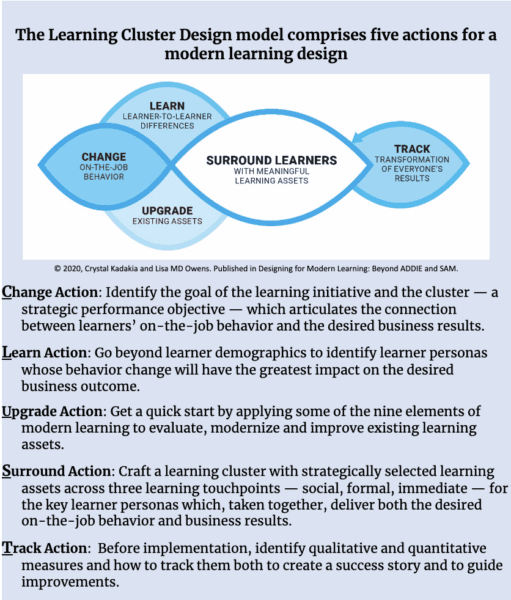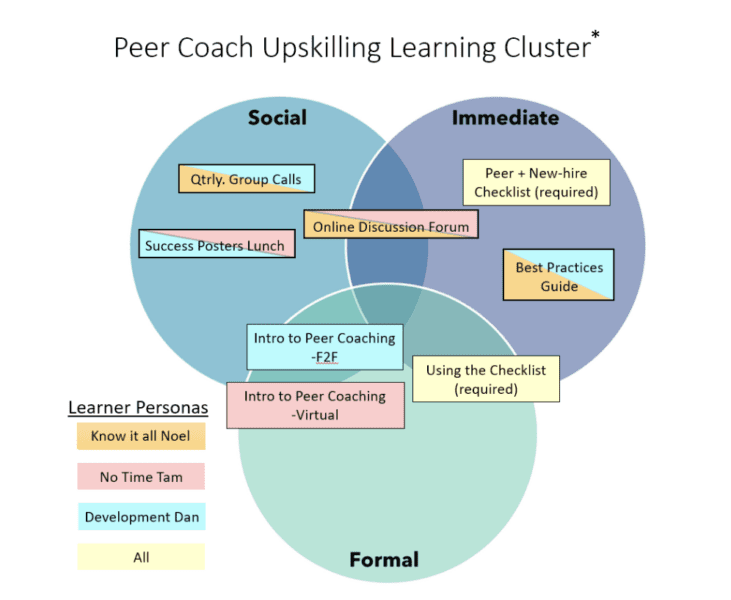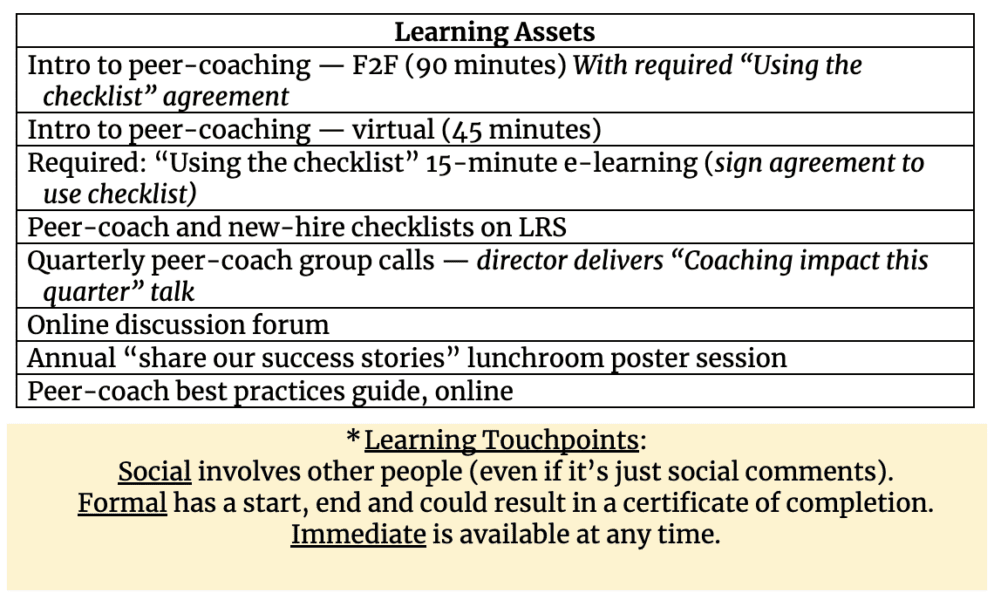Have you upgraded from offering just learning events? Let’s hope so, because we all know that one-and-done training doesn’t work. Our brains need learning spaced over time and in the moment of need.
Perhaps you now offer blended learning, learning journeys or learning experiences. Unfortunately, you’re still behind the times, and likely making less impact than you’re hoping for. To deliver more value for the business and your learners, take modernizing one step further. Shift your learning offerings from training to learning clusters.
A learning cluster is a group of learning assets that target on-the-job behavior change for a specific business need. Learning assets are learning offerings that can be as big as a multi-week class, or as small as a two-minute video or interactive PDF, and used at the moment of learning need.
Degreed’s 2021 research report, “How the Workplace Learns,” revealed that employees use formal learning about once a quarter. Yet Degreed also reports that employees are learning every month, week and sometimes, everyday. If our learning and development offerings are used so irregularly, we lack impact on the job and L&D becomes irrelevant. If learners need to learn more often, how can L&D apply our learning expertise to guide and support these learners?
A growing number of L&D professionals and organizations are shifting to learning clusters as their primary deliverable, instead of only delivering formal training.
L&D’s modern deliverable
By definition, formal training or learning programs have a start and end, and are typically prescriptive learning. Alternatively, learning clusters are groups of learning assets that are presented to people to help them achieve a goal or do their job better.
Learning clusters are differentiated from typical training offerings because clusters:
- Focus on changing specific workplace behaviors that benefit the business, often in a measurable way.
- Put employees in control, with L&D’s offerings as their go-to support system. Employees choose which learning assets to use (or not use), with very limited required training or training paths, with “performance” as the primary requirement or driver.
- Are grouped to be easily found, and cover three learning touchpoints: social, formal and immediate.
- Are designed to meet the learning needs of key learner personas, who have diverse learning needs, and who are most likely to make a difference for the business when they change their on-the-job behavior through learning.
- Address the five moments of learning need: apply, change, solve, new, more.
- Provide L&D with a strategy for choosing (or not choosing) new technologies from among the thousands of new offerings.
Think about it: When you offer blended learning, a learning journey or a learning experience, are you still offering a single curriculum or asset? And, if you already offer multiple assets, are you expecting learners to follow a sequence or come to your platform to find the assets? If you answered yes, learning cluster design can take you to a higher level of impact.
As you move to learning clusters, you will offer multiple assets, when, where and how learners most want and need them. And, it’s up to learners to decide which assets to use, and when. After all, they are the ones learning and applying their learning on-the-job.
Easier to deliver
Learning clusters are typically easier to design because learning assets do not contain every crumb of content. Assets are created in an agile fashion over time, so deployment begins sooner. Compare that to typical training programs that need to be fully designed and piloted before deployment. In today’s fast-paced, ever-changing modern workplace, L&D rarely has that kind of time. Learning clusters are the modern agile L&D approach.
An example speaks a thousand words

Here is an example based on a real-life learning cluster design:
The situation: Last year, new-hire retention improved after a peer-coaching program was put in place for new-hires. Not all teams used the peer-coaching approach, and success varied by coach. After research uncovered which coaching practices consistently had a positive impact on retention, L&D recommended the program be rolled out companywide with upskilling for peer-coaches. The L&D team delivered a learning cluster to achieve the upskilling.
Change: The L&D team established an SPO as part of the Change Action. The final version of the SPO read like this:
By expanding the new-hire peer-coaching program and by upskilling coaches, the business will benefit from a 15 percent reduction in turnover within the next year. Desired behavior changes that we expect to see on the job include:
- A 90 percent completion rate of the onboarding checklist by both peer-coach and new-hire.
- Weekly meetings for the pairs on their calendars for the first two months.
- More peer-coach and new-hire pairs are visible in the office.
Learn: Through interviews with stakeholders and potential peer coaches, the L&D team learned more about their learners and identified three learner personas whose upskilling could make a big difference on the results. Each persona had significantly different learning needs:
Know-it-all Noel: Seasoned peer coach who believes he’s effective now, but skips key steps.
No-time Tam: Wants to be a peer coach, but lacks skills and worries about lack of time.
Development Dan: Likes to develop himself and others, good mentor, prefers face-to-face learning.
Upgrade: Last year, in a two-hour face-to-face class, peer-coach volunteers learned how the program worked. Now, the class was quickly upgraded for the next round of hiring. To modernize it, L&D did things like chunking it into a shorter class with heavy use of hyperlinks to job aids and resources.
Surround: Learning assets were selected to target each learner persona’s needs with at least one asset at each learning touchpoint. Peer-coaches choose what they need, when they need it, at a new “Peer-Coaching” webpage. One e-learning course is required.
L&D’s learning cluster design is visualized below, with a “Learning Cluster Venn Diagram” and a summary table of assets and their targets.


Track: Because measures were sorted out during the Change Action, it was clear what the goals were, how to get the data and who wanted to see which reports and at what frequency. If anything was off-target, L&D could quickly get things back on track without waiting for end-of-quarter reports. The Annual “Share Our Success Stories” lunchroom posters added the human stories that backed up the numbers reports.
Key differences between modern learning clusters and training
Learning clusters go beyond one-and-done. Design begins with the end in mind by identifying the link between learners’ on-the-job behavior and what the business wants to achieve. Notice in the example that assets address not only first-time peer coaches needs, but also learning needs when applying the skill and when needing additional learning or refreshers.
Learning clusters focus on learner needs by going beyond learner demographics. Instead, we seek to understand learner personas’ unique learning needs so we can better support them. Notice in the example that there are assets for every learner persona, but each asset isn’t one-size-fits-all, covering all personas. We can break away from our classrooms and, instead, place learning assets where the learner is likely to be, when that moment of learning need strikes. This deep understanding helps L&D choose the right technology, and perhaps justify new technologies to reach learners at their learning need moments. The idea is to help people do something on the job, rather than just learn something.
Learning clusters are designed with a holistic view to achieve behavior change. Our brains need spaced learning and in smaller chunks, aimed at our learning needs. Notice in the example, we imply that different assets have different content, and though there may be an asset that tries to “cover it all”— with this approach, designers aren’t forced to cram everything into one asset. Nor are learners required to try to learn things they already know. With this approach, we’re more likely to deliver business results and behavior change, than if we depend on a single training, no matter how well designed it might be.
Perspective from LCD practitioners
There’s a growing group of LCD model practitioners. These practitioners tend to fall into the following categories. Which group might you fall into?
- It’s breakthrough thinking. These practitioners are reorganizing their L&D staff to deliver learning cluster offerings. The oft-mentioned breakthroughs are, first, using learning clusters to gain authority beyond the classroom, and second adopting a new paradigm that L&D’s goal is to achieve OTJ behavior change instead of achieving learning alone.
- It’s the next step in our modernization journey. Others find that the LCD model moves them further along the path to modernization by providing them the much needed thinking and process to go beyond blended learning, e-learning, VILT and videos. It helps by tweaking their use of learner personas, focusing more clearly on on-the-job change or discovering new ways to measure learning impact.
- We needed this codification. Some LCD practitioners say that, intuitively, they were already doing things that are built into the Learning Cluster Design model, but didn’t have a name or consistent process for it. The LCD model codifies their process, making it more repeatable and helps them bring team members on board with these concepts. They also appreciate the new LCD language, which works when used with stakeholders to gain more support, a stronger reputation and improved relationships.
The next question is: Will you take the plunge and modernize by offering learning clusters instead of simple training? What difference do you see between learning cluster design and what you do today, that can help you and your organization?















